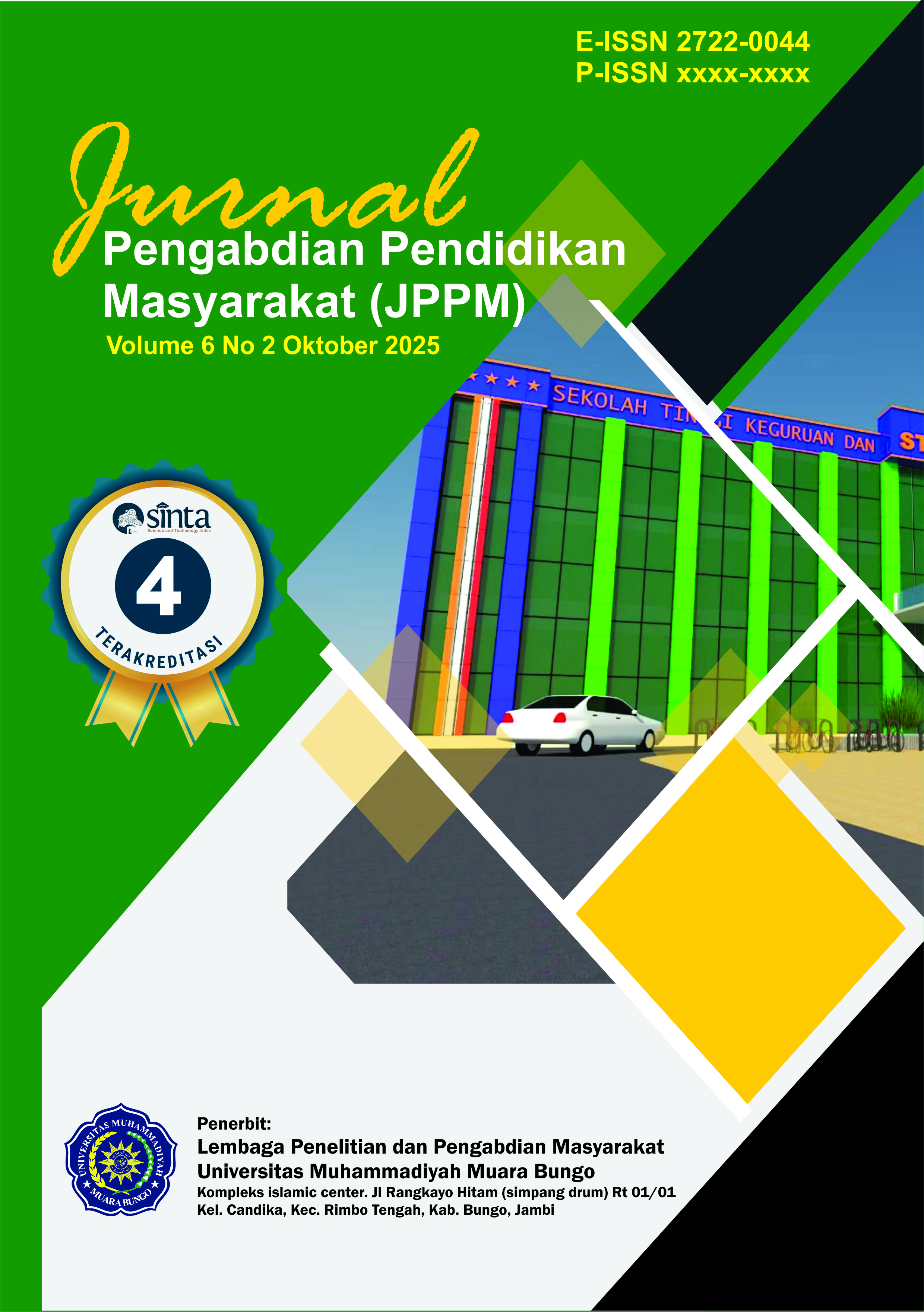INTEGRASI SENSORI MELALUI BRAIN-GYM DENGAN LAGU DAERAH DI SATUAN PAUD SEJENIS ASTER 131 JEMBER
Abstract
This community service activity aimed to enhance the capacity of educators at similar early childhood education units Aster 131 Jember in applying sensory integration stimulation through a multisensory approach—specifically, brain gym activities accompanied by regional songs. The program was initiated in response to the diverse developmental conditions of the students and the teachers’ limited access to media for introducing art and local culture. Therefore, an innovative learning strategy was needed to support both inclusive education and cultural introduction. The activity was carried out in five stages: initial survey, awareness-raising session, training of trainers (ToT), implementation of pre-learning activities with students, monitoring, and post-intervention evaluation. Data were collected through pre- and post-tests for teachers and a satisfaction survey administered after the program. The results indicated an increase in teachers’ understanding of the importance of sensory integration in early childhood, improvement in their skills in implementing brain gym activities, and active student participation in pre-learning sessions that combined motor skills and local cultural elements. The satisfaction survey showed that teachers found this method enjoyable, easy to apply, and relevant to children's needs. This initiative recommends the implementation of culturally grounded multisensory approaches as an effective strategy to support inclusive and high-quality early childhood education.
References
Agustriana, E. (2014). Efektivitas Penggunaan Video Pembelajaran Untuk Meningkatkan Hasil Belajar Ekonomi Siswa SMA. Jurnal Pendidikan Dan Pembelajaran Khatulistiwa, 3(8), 1–12.
Aldrich, J. E., & Shelly, T. (2006). See me! Hear me! Touch me! Move me! Sensory activities in the early childhood classroom. Intervention in School and Clinic, 42(1), 54–55. https://doi.org/10.1177/10534512060420011001
Galdi, M., D’Anna, C., Pastena, N., & Paloma, F. G. (2015). Gross-motor Skills for Potential Intelligence Descriptive Study in a Kindergarten. Procedia - Social and Behavioral Sciences, 174, 3797–3804. https://doi.org/10.1016/j.sbspro.2015.01.1115
Hikmah, N., Saudah, S., & Muzakki, M. (2024). Analisis Pemahaman Guru Raudhatul Athfal tentang Aspek Perkembangan Nilai Agama dan Moral, Kognitif dan Fisik-Motorik di Kota Palangka Raya. BOCAH: Borneo Early Childhood Education and Humanity Journal, 3(1), 1–13. https://doi.org/10.21093/bocah.v3i1.7762
Hsu, H. jen, & Tseng, Y. T. (2024). Impaired motor skills and proprioceptive function in Mandarin-speaking children with developmental language disorder. Brain and Language, 251(January), 105390. https://doi.org/10.1016/j.bandl.2024.105390
Jalilinasab, S., Saemi, E., & Abedanzadeh, R. (2022). Fundamental motor and social skills of children: the role of Brain Gym exercise. Early Child Development and Care, 192(14), 2256–2267. https://doi.org/10.1080/03004430.2021.2003350
Lawrence, K., Estrada, R. D., & McCormick, J. (2017). Teachers’ Experiences With and Perceptions of Students With Attention Deficit/hyperactivity Disorder. Journal of Pediatric Nursing, 36, 141–148. https://doi.org/10.1016/j.pedn.2017.06.010
Mimouni-Bloch, A., Tsadok-Cohen, M., & Bart, O. (2016). Motor Difficulties and Their Effect on Participation in School-Aged Children. Journal of Child Neurology, 31(11), 1290–1295. https://doi.org/10.1177/0883073816653783
Nelson, S. (2009). Sensory Integration Dysfunction “The Misunderstood, Misdiagnosed and Unseen Disability.”http://ciazabezalkoholu.pl/images/file/Angielskie/Terapia/Sensory-Integration-Dysfunction.pdf
Rifka Alkhilyatul Ma’rifat, I Made Suraharta, I. I. J. (2024). Peningkatan Kemampuan Pengenalan Sejarah Budaya Minangkabau Melalui Lagu Kreasi Minangkabau Bagi Anak Usia Dini. 2, 306–312.
Rizqullah, R. A., Muzaki, A., & Nursalim, A. (2023). Penerapan Kegiatan Brain Gym untuk Meningkatkan Kosentrasi Belajar. Jurnal Konatif: Jurnal Ilmiah Pendidikan, 1(1), 14–33. https://doi.org/10.62203/jkjip.v1i1.7
Roley, S. S., Mailloux, Z., Miller-Kuhaneck, H., & Glennon, T. (2007). Understanding Ayres Sensory Integration®. OT Practice, 12(17).
Roodbarani, M., Tagharrobi, Z., Sharifi, K., Sooki, Z., & Zare, M. (2024). Influence of Brain Gym on children’s behavioral problems with autism spectrum disorder: A randomized controlled clinical trial. Journal of Bodywork and Movement Therapies, 40(April), 1248–1254. https://doi.org/10.1016/j.jbmt.2024.07.048
Westendorp, M., Hartman, E., Houwen, S., Smith, J., & Visscher, C. (2011). The relationship between gross motor skills and academic achievement in children with learning disabilities. Research in Developmental Disabilities, 32(6), 2773–2779. https://doi.org/10.1016/j.ridd.2011.05.032
| Keywords | : |
Keywords:
Sensory Integration;, Brain-Gym;, Early Childhood Education; Integrasi Sensori;, Brain Gym;, Pendidikan Anak Usia Dini
|
| Galleys | : | |
| Published | : |
2025-09-29
|
| How to Cite | : |
Alifia Tittandi, N., Buroidah, H., Dwi Afifah, D., Salsabila, A., & Endarwati, K. (2025). INTEGRASI SENSORI MELALUI BRAIN-GYM DENGAN LAGU DAERAH DI SATUAN PAUD SEJENIS ASTER 131 JEMBER. Jurnal Pengabdian Pendidikan Masyarakat (JPPM), 6(2), 396–403. https://doi.org/10.52060/jppm.v6i2.3513
|
| Issue | : |



.png)


33.png)



_SCCC.png)

